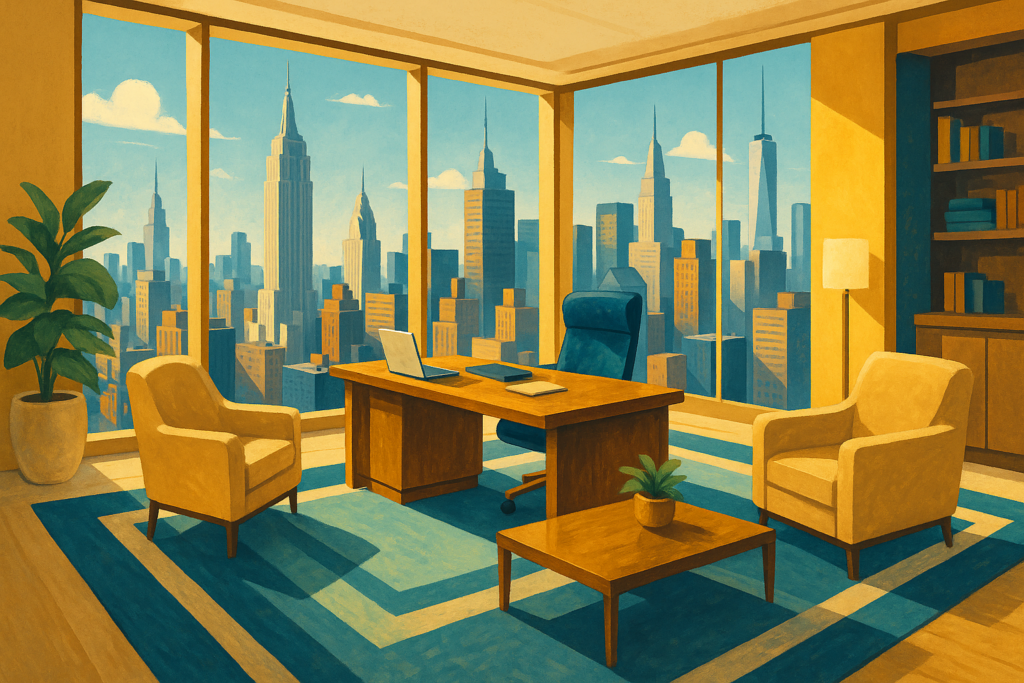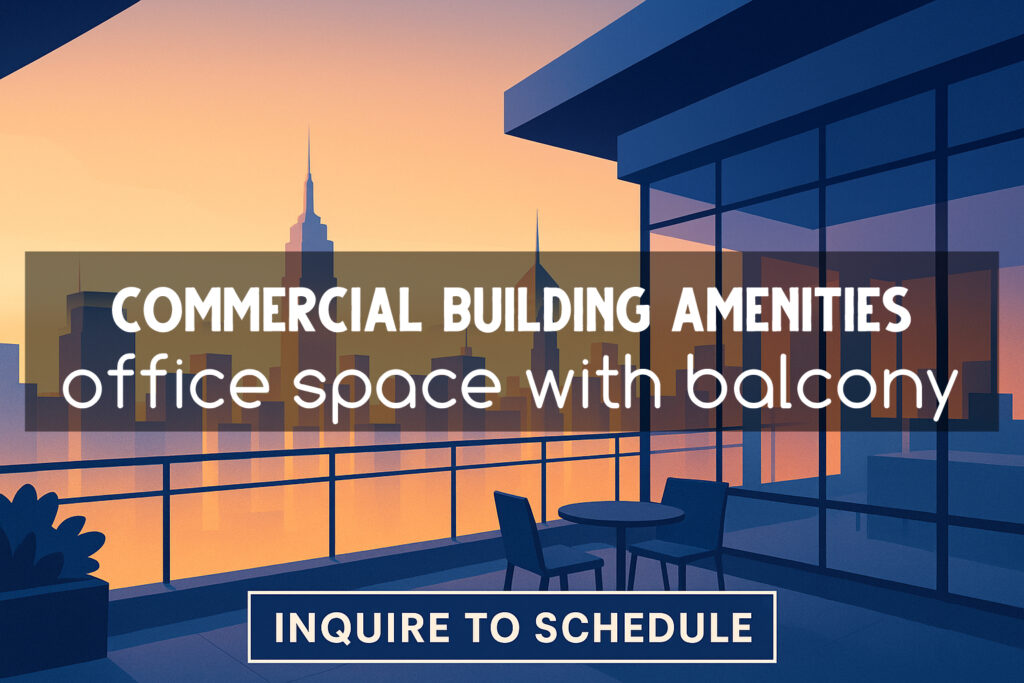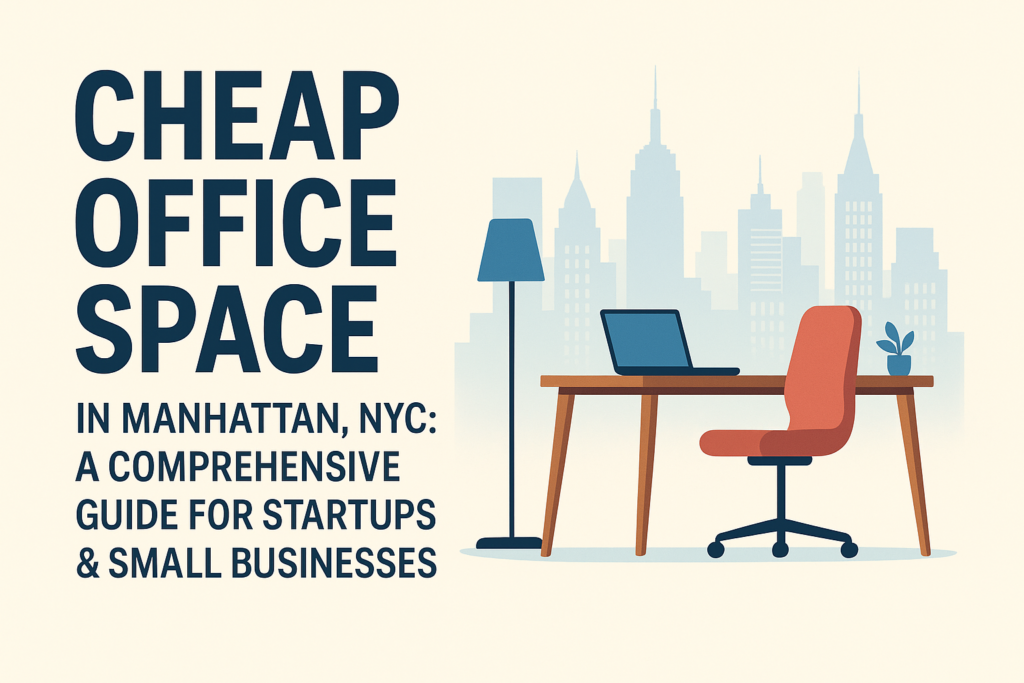Luxury Office Space Manhattan: High-End Design and Leasing
Luxury Office Space Manhattan; the commercial office landscape is synonymous with high-end image, blending historic grandeur with cutting-edge innovation. As the global epicenter of finance and a rising tech hub, Manhattan offers a unique office environment shaped by a century of investment, dense urban development, and constant adaptation. This guide delves into the design trends and leasing practices defining Manhattan’s premium office spaces – from towering Art Deco icons to modern sustainable skyscrapers – and provides insights for tenants seeking to find, secure, and negotiate luxury office space in New York City. We explore how Manhattan’s long-standing real estate legacy and urban density have evolved into today’s design standards, what top-tier tenants (from tech startups to financial firms) expect in their workplaces, and how developers are responding to post-COVID demands for flexible, wellness-focused, design-forward offices.

Manhattan’s Legacy of Luxury Office Buildings
Manhattan’s pedigree in commercial offices is unmatched – it boasts nearly 600 million square feet of office space, with an average building age approaching 100 years. This reflects more than a century of heavy investment in office towers, from the Beaux-Arts and Art Deco skyscrapers of the early 1900s to the glass-and-steel high-rises of the 21st century. These layers of development created a deep inventory of buildings, many of them iconic landmarks that still define “luxury” in office space. For example, the Chrysler Building and Empire State Building set a precedent for prestige and architectural grandeur that modern projects continue to draw inspiration from. The legacy of such structures means Manhattan’s high-end offices often blend historic character with modern amenities, offering ornate marble lobbies or classic façades alongside state-of-the-art interiors.
This long history also means much of Manhattan’s office stock is older and requires continual upgrading. The challenge for many landlords has been “renovate or bust” – investing in extensive modernizations or risk obsolescence. Over past decades, owners of premier buildings have poured capital into renovations: from infrastructure upgrades (HVAC, elevators, IT) to aesthetic overhauls preserving historic details. This constant reinvestment has kept Manhattan’s Class A and landmark buildings competitive with new construction, maintaining their luxury status even as tenant expectations evolve. It’s not uncommon for a pre-war tower with a classic façade to hide a completely modernized interior that meets the highest standards of technology and comfort.
Despite high costs, the payoff for creating truly exceptional space is evident in Manhattan. Elite developers create jaw-dropping spaces commanding rents from $70 up to $200 per square foot in trophy properties – and tenants pay these premiums because they understand that “exceptional space attracts exceptional talent.” In the top segment of the market, prestige and “wow factor” can outweigh budget concerns. Walking into a newly renovated high-rise with a soaring lobby or stepping onto an upper floor with panoramic Central Park views can instantly validate the cost for a company by helping to recruit and retain top talent. This dynamic has fueled Manhattan’s trophy office culture for generations, where the address and building name carry cachet.
Urban Density and the Vertical Campus Concept
One of the defining characteristics of Manhattan office design is how it responds to extreme urban density. Unlike cities where corporate campuses sprawl horizontally, Manhattan’s high-end offices grow vertical. Space is at a premium on this island, so luxury offices often occupy skyscrapers that stack amenities and workplaces in towers rather than across acres of land. In recent years, developers have embraced the idea of the “vertical campus” – essentially creating the amenities of a suburban tech campus within a Manhattan high-rise. For example, the ambitious Hudson Yards project built an entire “city within a city” over active train tracks on the West Side. These gleaming towers house not only millions of square feet of offices but also retail, dining, public plazas, and residential space – offering a self-contained campus-like environment in the sky.
Tech giants and creative firms that might elsewhere occupy spread-out campuses are finding ways to establish urban campuses in Manhattan. Often this means clustering multiple buildings in a neighborhood or transforming a single large building into a multi-faceted tech hub. A notable example is the redevelopment of 335 Madison Avenue into a vertical tech campus beside Grand Central. In this 1.1 million sq. ft. building, designers created an “innovative vertical campus” with amenities like a two-story glass-wrapped library, a rooftop terrace, a wellness center, event spaces, and curated dining venues. Likewise, new trophy towers like One Vanderbilt include private tenant lounges, world-class dining, and direct transit integration, reflecting how accessibility and lifestyle are now integral parts of office strategy.
Transit-oriented location is a major asset of Manhattan’s dense environment. High-end offices are typically situated near major transit hubs like Grand Central, Penn Station, or Fulton Center. This urban connectivity means a Manhattan office offers an experience larger than its four walls. Employees can step outside a Midtown tower and have five-star dining, luxury retail, and world-class arts within minutes – complementing in-building amenities to create a compelling workday ecosystem.
Adaptive Reuse and Sustainable Design Standards
Given Manhattan’s vast inventory of aging buildings, adaptive reuse and sustainability upgrades have become central to high-end office development. Developers increasingly transform older structures into “like-new” luxury workplaces. A leading example is the restoration of 120 Broadway, a 1915 landmark updated with state-of-the-art systems while preserving its iconic Beaux-Arts lobby. On the other end, obsolete towers like 55 Broad Street are being converted to residential – demonstrating Manhattan’s flexible reuse logic.
Sustainability is no longer a luxury – it’s expected. LEED Gold and Platinum certifications are now standard in top-tier buildings. One Vanderbilt, for instance, was constructed with 90% recycled steel and advanced energy systems. Developers like Vornado Realty Trust have retrofitted entire portfolios to meet LEED standards, aligning with both corporate ESG goals and NYC climate mandates.
Health and wellness certifications such as WELL have risen in tandem. Buildings like 425 Park Avenue and 550 Madison have achieved WELL certification, adding systems like enhanced ventilation, touchless entries, and biophilic design. At 550 Madison, renovations added public gardens, extensive tenant amenity floors, and a 30% improvement in fresh air circulation – blending legacy architecture with modern wellness infrastructure.
High-performance interiors are now baseline in luxury buildings: tunable lighting, acoustic privacy, circadian design, and modular layouts are standard. Modular construction and movable wall systems allow tenants to reconfigure space without lengthy downtime, while workplace “experience design” has become a focus. Curated amenities – barista bars, art programs, tenant apps, and hotel-grade lounges – now define what luxury feels like in the workplace.
Bespoke Design and Amenities for Manhattan Tenants
Every major tenant group brings unique design priorities:
- Tech and Creative Firms favor open, non-traditional layouts, breakout zones, and branding opportunities. They demand high infrastructure capacity and often gravitate toward loft-style spaces in converted buildings that preserve historical character while offering modern systems.
- Financial, Legal, and Corporate Firms still prioritize prestige, privacy, and polish – Park Avenue addresses, grand boardrooms, and executive finishes. Yet even these tenants now include wellness rooms, cafés, and collaboration zones in their layouts, balancing tradition with progressive design.
- All Tenants want flexibility. This includes modular planning, shorter lease terms, and built-in amenities. Outdoor space, air quality, touchless systems, and health-conscious programming are common expectations. Amenity-rich buildings – with gyms, rooftop gardens, food service, and event programming – are fast becoming the norm, not the exception.
Luxury Office Space Manhattan: Post-COVID Evolution and Market Dynamics
COVID-19 accelerated the office market’s bifurcation. Class A trophy towers are outperforming older Class B/C buildings, with occupancy in top properties nearing 95% of pre-pandemic levels. In contrast, older, amenity-poor buildings face rising vacancy and conversions. The most active tenants are moving into newer buildings or those with major upgrades, often reducing square footage but dramatically increasing space quality.
Landlords have responded with massive reinvestment. They’ve added wellness features, spec suites, flexible lease options, and coworking-style offerings. Some now offer entire floors divided into turnkey suites, aimed at tenants wanting flexible growth without long-term commitments.
Post-pandemic tenants place a premium on wellness and design. Developers who preserve a building’s luxury identity while discreetly adding air purification, hands-free access, and biophilic design will succeed. Across Manhattan, the emphasis is shifting toward curated experiences, not just square footage.
Comparing Manhattan Office Classes
| Building Class | Description | Amenities | Rent Range (PSF) |
|---|---|---|---|
| Trophy / Top Class A | New or renovated icons in prime areas. Architectural design, large column-free layouts, high ceilings. | Full concierge, fitness/wellness, lounges, gourmet dining, LEED/WELL Platinum. | $100–$200+ |
| Class A | Renovated within 20–30 years. Good infrastructure, central location. | Café, conference rooms, solid finishes, often LEED Gold. | $70–$100 |
| Class B | Older buildings, functional but dated systems. Often no major amenities. | Basic services, renovated lobbies, some upgrades. | $35–$60 |
| Class C | Unrenovated buildings, minimal services. Possible candidates for conversion. | Limited or no amenities. Often “as-is” condition. | <$40 |
What is by Definition
Luxury office space Manhattan or rather ‘in Manhattan’ refers to premium, high-end office spaces characterized by superior amenities, prime locations, and modern design, often found in Class A or trophy buildings. These spaces cater to businesses seeking a prestigious and efficient work environment, offering features like cutting-edge technology, sophisticated security, and high-end tenant services
Conclusion: The Evolving Landscape of Luxury Offices
Manhattan’s high-end office market remains one of the most dynamic and resilient in the world. From its architectural legacy to its new breed of wellness-driven, vertically integrated towers, the city continues to set global benchmarks for workplace excellence.
For tenants, the message is clear: today’s luxury office isn’t just an address – it’s a competitive asset. Whether you’re a startup seeking a high-impact creative space or a legacy firm demanding prestige and performance, Manhattan offers options that combine identity, innovation, and opportunity.
As the market continues to evolve, one truth endures: in Manhattan, the office is more than where you work – it’s where your company becomes what it is.

Finding Luxury Office Space Manhattan
If you’re exploring luxury office space in Manhattan, we can help you navigate the market with no obligation and at no cost. As tenant brokers, our role is to represent your interests—offering expert guidance, strategic insights, and access to listings that align with your business goals. Fill out the online form or call 212-967-2061 to receive a customized tenant space report detailing options that match your budget, image, preferred location, and daily operational needs.
Resources
Common Luxury Building Amenities


